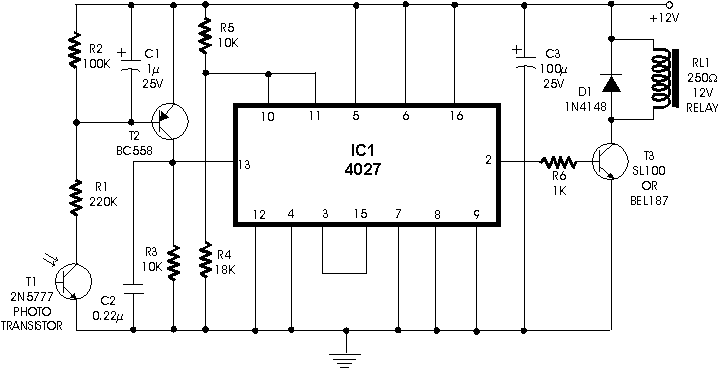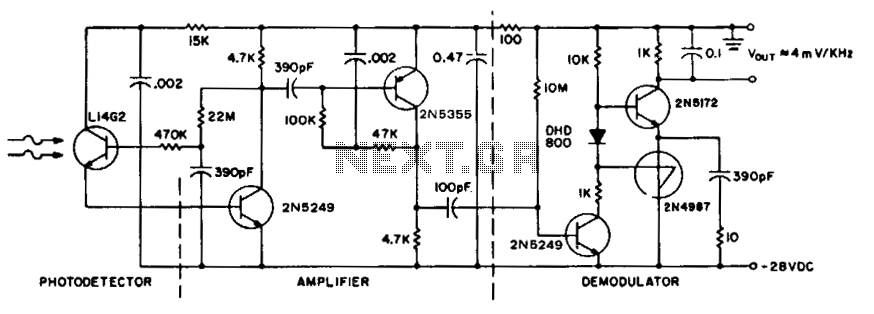
Optical toggle switch using a single Chip

An optical toggle switch utilizing a single chip. This design employs a dual flip-flop integrated circuit (IC) CD4027 and incorporates a 555-based monostable circuit to generate input clock pulses. The circuit outlined here eliminates the need for this configuration.
The optical toggle switch circuit utilizes the CD4027 dual flip-flop IC, which is capable of toggling its output state based on the input clock pulses. The CD4027 consists of two independent flip-flops, allowing for versatile applications in digital logic designs. The integration of a 555 timer configured in a monostable mode serves to create precise timing pulses that act as the clock signal for the flip-flops.
In this configuration, the output of the 555 timer can be connected to the clock input of the CD4027, where each pulse from the timer will toggle the state of the flip-flop. This setup can be particularly useful in applications where optical isolation is required, as the optical components can control the toggle action without direct electrical connections, thereby enhancing safety and reducing noise interference.
The circuit can be powered using a standard DC power supply, and the output from the flip-flop can be used to drive other components, such as LEDs or relays, to indicate the toggle state. The design can be further enhanced by adding additional features such as debounce circuits or LED indicators to provide visual feedback of the switch status.
Overall, this optical toggle switch circuit provides a reliable and efficient method for controlling electronic devices with minimal components, making it suitable for various applications in automation, remote control systems, and more.Optical toggle switch using a single Chip. Using dual flip-flop IC CD4027 employ a 555 based monostable circuit to supply input clock pulses. The circuit described here obviates this requirement. One. 🔗 External reference
The optical toggle switch circuit utilizes the CD4027 dual flip-flop IC, which is capable of toggling its output state based on the input clock pulses. The CD4027 consists of two independent flip-flops, allowing for versatile applications in digital logic designs. The integration of a 555 timer configured in a monostable mode serves to create precise timing pulses that act as the clock signal for the flip-flops.
In this configuration, the output of the 555 timer can be connected to the clock input of the CD4027, where each pulse from the timer will toggle the state of the flip-flop. This setup can be particularly useful in applications where optical isolation is required, as the optical components can control the toggle action without direct electrical connections, thereby enhancing safety and reducing noise interference.
The circuit can be powered using a standard DC power supply, and the output from the flip-flop can be used to drive other components, such as LEDs or relays, to indicate the toggle state. The design can be further enhanced by adding additional features such as debounce circuits or LED indicators to provide visual feedback of the switch status.
Overall, this optical toggle switch circuit provides a reliable and efficient method for controlling electronic devices with minimal components, making it suitable for various applications in automation, remote control systems, and more.Optical toggle switch using a single Chip. Using dual flip-flop IC CD4027 employ a 555 based monostable circuit to supply input clock pulses. The circuit described here obviates this requirement. One. 🔗 External reference





